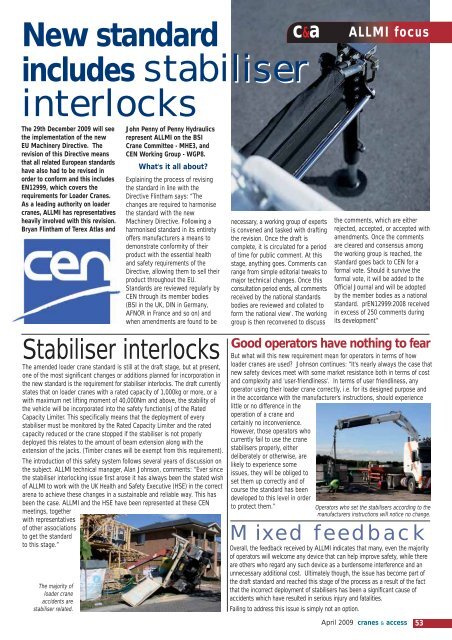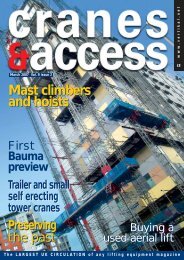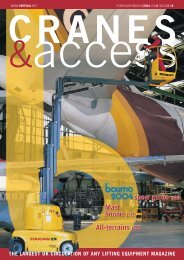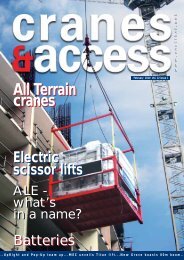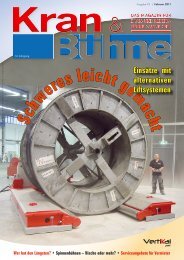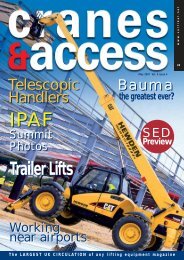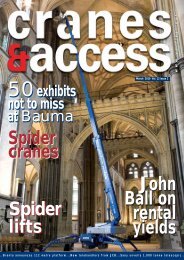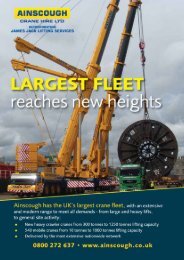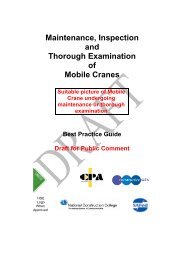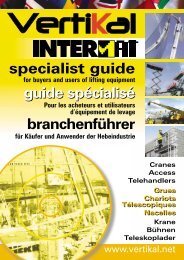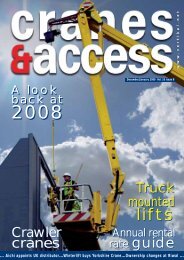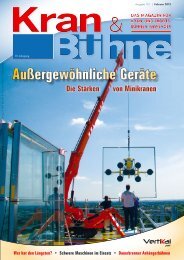Create successful ePaper yourself
Turn your PDF publications into a flip-book with our unique Google optimized e-Paper software.
The 29th December 2009 will see<br />
the implementation of the new<br />
EU Machinery Directive. The<br />
revision of this Directive means<br />
that all related European standards<br />
have also had to be revised in<br />
order to conform and this includes<br />
EN12999, which covers the<br />
requirements for Loader Cranes.<br />
As a leading authority on loader<br />
cranes, ALLMI has representatives<br />
heavily involved with this revision.<br />
Bryan Flintham of Terex Atlas and<br />
c&a<br />
New standard<br />
includes stabiliser<br />
stabiliser<br />
interlocks<br />
John Penny of Penny Hydraulics<br />
represent ALLMI on the BSI<br />
Crane Committee - MHE3, and<br />
CEN Working Group - WGP8.<br />
What's it all about?<br />
Explaining the process of revising<br />
the standard in line with the<br />
Directive Flintham says: “The<br />
changes are required to harmonise<br />
the standard with the new<br />
Machinery Directive. Following a<br />
harmonised standard in its entirety<br />
offers manufacturers a means to<br />
demonstrate conformity of their<br />
product with the essential health<br />
and safety requirements of the<br />
Directive, allowing them to sell their<br />
product throughout the EU.<br />
Standards are reviewed regularly by<br />
CEN through its member bodies<br />
(BSI in the UK, DIN in Germany,<br />
AFNOR in France and so on) and<br />
when amendments are found to be<br />
Stabiliser interlocks<br />
The amended loader crane standard is still at the draft stage, but at present,<br />
one of the most significant changes or additions planned for incorporation in<br />
the new standard is the requirement for stabiliser interlocks. The draft currently<br />
states that on loader cranes with a rated capacity of 1,000kg or more, or a<br />
with maximum net lifting moment of 40,000Nm and above, the stability of<br />
the vehicle will be incorporated into the safety function(s) of the Rated<br />
Capacity Limiter. This specifically means that the deployment of every<br />
stabiliser must be monitored by the Rated Capacity Limiter and the rated<br />
capacity reduced or the crane stopped if the stabiliser is not properly<br />
deployed this relates to the amount of beam extension along with the<br />
extension of the jacks. (Timber cranes will be exempt from this requirement).<br />
The introduction of this safety system follows several years of discussion on<br />
the subject. ALLMI technical manager, Alan Johnson, comments: “Ever since<br />
the stabiliser interlocking issue first arose it has always been the stated wish<br />
of ALLMI to work with the UK Health and Safety Executive (HSE) in the correct<br />
arena to achieve these changes in a sustainable and reliable way. This has<br />
been the case. ALLMI and the HSE have been represented at these CEN<br />
meetings, together<br />
with representatives<br />
of other associations<br />
to get the standard<br />
to this stage.”<br />
The majority of<br />
loader crane<br />
accidents are<br />
stabiliser related.<br />
necessary, a working group of experts<br />
is convened and tasked with drafting<br />
the revision. Once the draft is<br />
complete, it is circulated for a period<br />
of time for public comment. At this<br />
stage, anything goes. Comments can<br />
range from simple editorial tweaks to<br />
major technical changes. Once this<br />
consultation period ends, all comments<br />
received by the national standards<br />
bodies are reviewed and collated to<br />
form 'the national view'. The working<br />
group is then reconvened to discuss<br />
ALLMI focus<br />
the comments, which are either<br />
rejected, accepted, or accepted with<br />
amendments. Once the comments<br />
are cleared and consensus among<br />
the working group is reached, the<br />
standard goes back to CEN for a<br />
formal vote. Should it survive the<br />
formal vote, it will be added to the<br />
Official Journal and will be adopted<br />
by the member bodies as a national<br />
standard. prEN12999:2008 received<br />
in excess of 250 comments during<br />
its development”<br />
Good operators have nothing to fear<br />
But what will this new requirement mean for operators in terms of how<br />
loader cranes are used? Johnson continues: “It's nearly always the case that<br />
new safety devices meet with some market resistance both in terms of cost<br />
and complexity and 'user-friendliness'. In terms of user friendliness, any<br />
operator using their loader crane correctly, i.e. for its designed purpose and<br />
in the accordance with the manufacturer's instructions, should experience<br />
little or no difference in the<br />
operation of a crane and<br />
certainly no inconvenience.<br />
However, those operators who<br />
currently fail to use the crane<br />
stabilisers properly, either<br />
deliberately or otherwise, are<br />
likely to experience some<br />
issues, they will be obliged to<br />
set them up correctly and of<br />
course the standard has been<br />
developed to this level in order<br />
to protect them.”<br />
Mixed feedback<br />
Overall, the feedback received by ALLMI indicates that many, even the majority<br />
of operators will welcome any device that can help improve safety, while there<br />
are others who regard any such device as a burdensome interference and an<br />
unnecessary additional cost. Ultimately though, the issue has become part of<br />
the draft standard and reached this stage of the process as a result of the fact<br />
that the incorrect deployment of stabilisers has been a significant cause of<br />
accidents which have resulted in serious injury and fatalities.<br />
Failing to address this issue is simply not an option.<br />
Operators who set the stabilisers according to the<br />
manufacturers instructions will notice no change.<br />
April 2009 cranes & access 53


